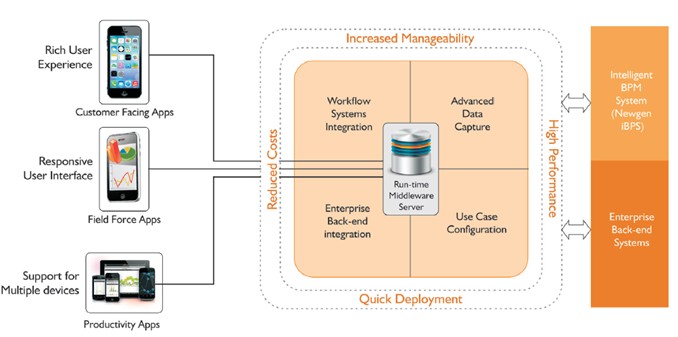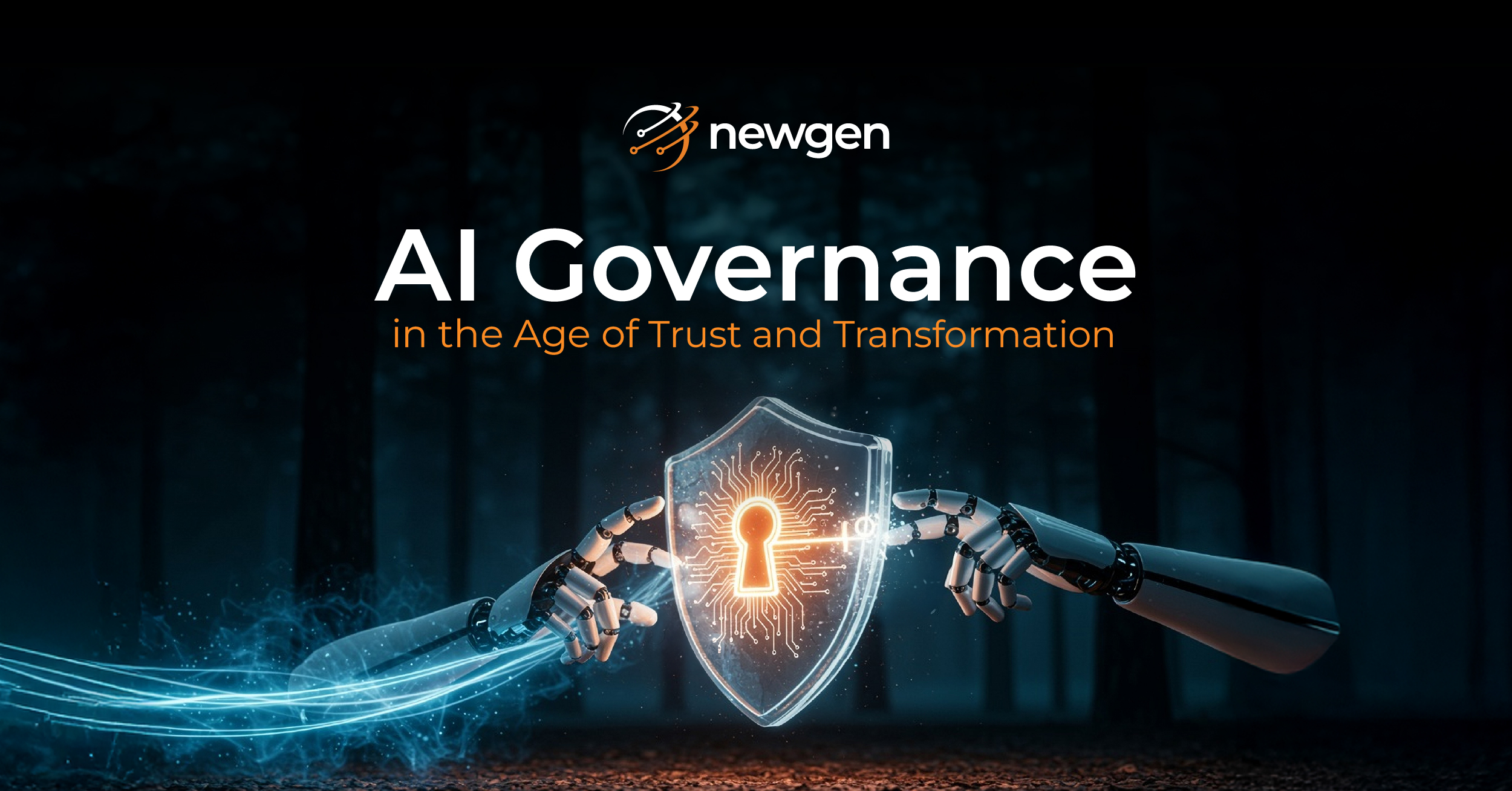Business ecosystems have evolved from value chain to value web, allowing customers to participate as part of the business model. Leveraging mobility, enterprises can adopt such a dynamic ecosystem. However, in the process of going mobile, are organizations just building another silo?
BPM as a Mobile Application Development Platform
Over the last few years, business leaders and enterprise architects have been collaborating to reinvent enterprise applications, leveraging mobility. The factors compelling businesses to adopt this change are the consumerization of enterprise apps, changing business models, and an opportunity to leverage extensive features of mobile apps such as audio-video-photographs support, geo enablement, synch & share, offline support, and others.

Though the pure play mobile application development platforms have proven their value to the enterprise architects, however they are subject to limitations due to the inherent nature of apps which are largely driven by server side rules, policies and integrations.
BPM has ever been the first choice for building Enterprise Applications that need complex rules, multiple integrations and varied processes. And, many such applications are already built on BPM. This led BPM to organically evolve to either integrate natively with mobile application development platform or provide its capabilities through traditional process modeling environment.
The BPM, Mobile and Enterprise Application Equation
The dilemma which businesses face is whether to opt for a responsive UI or a mobile application. Every business has different needs. To some a responsive UI may suffice but, some may demand for a process experience with extensive features like offline support, document capture, image enhancements etc which a mobile app can offer.
Organizations while making a strategic IT plan for different Enterprise Applications should plan for both the options. A mobile application development framework integrated with a BPM platform can fulfill the organizational needs and deliver process experience.
To understand, let’s take a use case of an audit inspector visiting a site for inspection.
An audit inspector visits a site. He captures images of the inventory warehouse which, as per his observation, is not compliant with the statutory guidelines. To validate his new observations, he wants to access more information about the organization and earlier audit reports and interactions. He sends the captured images and the recorded information to the audit coordinator for further examination. Post-examination the coordinator sends his remarks. The inspector then records all the information in a formal format and initiates a process for internal approvals on the new findings and for compiling the final report.
A few inferences from the above case:
- To allow for real-time processing and increased efficiency, the mobile application should be integrated with the other back-end core applications
- To automate enterprise processes as part of the use case, a strong backbone of Business Process Management (BPM) platform is needed
- Mobile application as against standard desktop application should leverage device capabilities such as capture, offline support, geo tagging etc.
- Despite the additional capabilities of the mobile devices, most of this is rule-based and policy driven which is controlled as part of server application or a process
Organizations have been leveraging BPM for streamlining processes, reducing operational efficiencies, enhancing their customer’s experience and complying with plethora of regulatory norms and guidelines. BPM when integrated with a mobility framework, transforms business processes and creates new synergies.
With BPM and mobility working hand-in-hand, it offers the best of both the worlds. Consider the same case of the audit inspector visiting the site with the only difference that this time he’s backed with BPM. The inspector would capture images of the warehouse, transfer real-time information to office, initiate parallel processing, receive feedback from the coordinator, access dashboards to make decisions on the field and gain further insights.
BPM – an orchestrator for Mobile Applications
BPM has transformed processes across industries such as banking, insurance, government, telecom and healthcare. With defined business rules, it facilitates users to auto-prioritize cases, handle exceptions, escalate and aid decision making with extensive dashboards. Tracking capabilities ensure end- to-end visibility and complete monitoring across processes, offering better accountability.
Leveraging BPM and mobility together is the best option for developing a mobile app enabled enterprise application.
However, in many organizations, they have existing systems and instead would require extensive integration capabilities for their users especially, the ones interacting with customers to make decisions on-the-fly. For instance, a mobile app for a relationship manager would empower him to access information from CRM, core application and other applications, allowing for a contextual customer interaction and better service experience. Even in such cases, most of the integrations and orchestrations are done at the server, where again a BPM platform would serve to provide a uniform interface across different enterprise apps.
Newgen Enterprise Mobility Framework (NEMF)
NEMF is a framework to develop, deploy and manage highly configurable hybrid mobile apps, supporting multiple platforms. With its plug and play components and capabilities for enterprise level security, advanced data and document capture, and ready adaptors for back-end integration, it facilitates enterprises for rapid and low-code app development.
The framework enables organizations build their mobility portfolio with following solutions :
Zapin
It is an enterprise mobile capture platform with advanced imaging capabilities such as extraction, image enhancement and compression. Leveraging our BPM capabilities, it empowers field agents to make decisions on-the-go and enhances customer service delivery model, offering services anytime-anywhere.
Mobile ECM
The solution offers capabilities such as document upload, document search, view and annotate, leveraging Newgen’s Enterprise Content Management (ECM). It allows enterprises to be more accountable and transparent as they can now easily share information and collaborate. Voice based search allows field agents to easily search customer information and ensure contextual interaction.
Mobile BPM
Businesses can ensure continuous operations with user-defined access to cases, work steps and processes. Mobile BPM allows for real-time processing, enabling field executives to initiate a process/case, send case for approval, share observations, generate and analyze reports in real-time from their mobile devices.
Smart Apps
The solution offers multiple applications, addressing the needs of various industries such as Banking, Insurance, Telecom, Government, Healthcare and others. It offers multiple business applications such as Collection, e-KYC, First Notice of Loss (FNOL), Claims, Customer On-boarding, Inspection, Municipality, Customer servicing and others.

Newgen Enterprise Mobility Framework
Mobility is the digital imperative for businesses to ensure continuous business operations. The NEMF framework, leveraging BPM capabilities enables you to become truly mobile and boundary-less. It breaks the silos, integrates your mobile processes with back-end systems and offers a collaborative- mobile environment. With comprehensive imaging features, ready-to-use accelerators, multilingual support, and ready integration with leading MDM, it offers a platform for enterprise mobile imperatives.
You might be interested in




